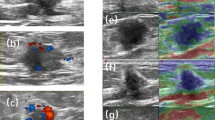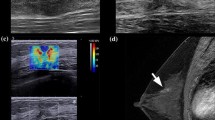Abstract
The purpose of this study was to investigate tumor blood flow in breast cancers with regard to its impact on the overall survival of patients. Tumor blood flow was assessed in seventy-four patients with primary breast cancer by the use of color-coded Doppler ultrasound techniques. Preoperatively obtained Doppler frequency spectra were analyzed for peak systolic flow velocity (Vmax). Color Doppler signals were detected in 71 (96%) of the breast tumors. Out of 74 patients, 17 experienced a relapse or distant metastasis, and 15 women had died due to breast cancer at the time of data analysis. The mean Vmax of the patients who had died was 0.27 m s−1, whereas survivors showed a mean Vmax of 0.16 m s−1(p=0.01.
Vmax, nodal status, and progesterone receptor status remained the only significant factors of overall survival in the multivariate model, whereas tumor size, tumor grade, and estrogen receptor status failed to retain prognostic significance. Moreover, Vmax was identified as the most important prognostic marker for survival in our series. The five-year-survival was 82.3% in Vmax≤ 0.25 m s−1 patients versus 36.6% in women with tumor flow greater than 0.25 m s−1. Patients with Vmax > 0.25 m s−1 experienced a 4.33-fold increased risk of death secondary to the underlying disease.
In summary, our data showed that tumor blood flow velocity measured by ultrasonography is an independent prognostic factor of survival in breast cancer patients. Furthermore, tumor flow velocity allows identification of patients at very high risk of death due to breast cancer. Large scale clinical trials should evaluate the clinical usefulness and future impact of this procedure for adjuvant treatment decisions.
Similar content being viewed by others
References
Carter CL, Allen C, Henson DE: Relation of tumor size, lymph node status, and survival in 24,740 breast cancer cases. Cancer 63: 181–187, 1989
Bloom HJ, Richardson WW: Histologic grading and prognosis in breast cancer: a study of 1409 cases of which 359 have been followed for 15 years. Br J Cancer 11: 359–377, 1957
McGuire WL, Tandon AK, Allred DC, Chamness GC, Clark GM: Howto use prognostic factors in axillary node-negative breast cancer patients. J Natl Cancer Inst 82: 1006–1015, 1990
Burger MM, Folkman J: UICC study group on basic and clinical cancer research: tumor angiogenesis. Int J Cancer 56: 311–313, 1994
Folkman J: Tumor angiogenesis: therapeutic implications. N Engl J Med 285: 1182–1186, 1971
Folkman J: How is blood vessel growth regulated in normal and neoplastic tissue? –GHA Clowes Memorial Award Lecture. Cancer Res 46: 467–473, 1986
Folkman J, Watson K, Ingber D: Induction of angiogenesis during the transition from hyperplasia to neoplasia. Nature 339: 58–62, 1989
Weidner N, Semple SP, Welch WR, Folkman J: Tumor angiogenesis and metastasis – correlation in invasive breast carcinoma. N Engl J Med 324: 1–8, 1991
Weidner N, Folkman J, Pozza F, Bevilaqua P, Allred EN, Moore DH, Meli S, Gasparini G: Tumor angiogenesis: a new significant and independent prognostic indicator in earlystage breast carcinoma. J Natl Cancer Inst 84: 1875–1887, 1992
Bosari S, Lee AK, Delellis RA, Wiley BD, Heatley GJ, Silverman ML: Microvessel quantitation and prognosis in invasive breast carcinoma. Hum Pathol 23: 755–761, 1992
Gasparini G, Weidner N, Bevilacqua P, Maluta S, Dalla Palma P, Caffo O, Barbareschi M, Marubini E, Pozza F: Tumor microvessel density, p53 expression, tumor size and peritumoral lymphatic vessel invasion are relevant prognostic markers in node-negative breast carcinoma. J Clin Oncol 12: 454–466, 1994
Fox SB, Leek RD, Smith K, Hollyer J, Greenall M, Harris A: Tumor angiogenesis in node-negative breast carcinomas – relationship with epidermal growth factor, estrogen receptor and survival. Breast Cancer Res Treat 29: 109–116, 1994
Bevilacqua P, Barbareschi M, Verderio P, Boracchi P, Caffo O, Dalla Palma P, Meli S, Weidner N, Gasparini G: Prognostic value of intratumoral microvessel density, a measure of tumor angiogenesis, in node-negative breast carcinoma – results of a multiparametric study. Breast Cancer Res Treat 36: 205–217, 1995
Toi M, Inada K, Suzuki H, Tominaga T: Tumor angiogenesis in breast cancer: its importance as a prognostic indicator and the association with vascular endothelial growth factor expression. Breast Cancer Res Treat 36: 193–204, 1995
Obermair A, Kurz C, Czerwenka K, Thoma M, Kaider A, Wagner T, Gitsch G, Sevelda P: Microvessel density and vessel invasion in lymph-node negative breast cancer: effect on recurrence-free survival. Int J Cancer 62: 126–131, 1995
Cosgrove DO, Bamber JC, Davey JB, McKinna JA, Sinnet HD: Color Doppler signals from breast tumors. Radiology 176: 175–180, 1990
Burns PN, Halliwell M, Wells PNT: Ultrasonic Doppler studies of the breast. Ultrasound Med Biol 8: 127, 1982
Srivastava A, Webster DJT, Woodcock JP: Role of Doppler ultrasound flowmetry in the diagnosis of breast lumps. Br J Surg 75: 851–853, 1988
Dock W, Grabenwoger F, Metz V: Tumor vascularisation: assesment with Duplex sonography. Radiology 181: 241–244. 1991
Sohn C, Grischke EM, Wallwiener D: Ulrasound diagnosis of blood flow in benign and malignant breast tumors: Geburtsh u Frauenheilk 52: 397–403, 1992
Dixon JM, Walsh J, Paterson D: Color Doppler ultrasonography studies of benign and malignant breast lesions. Br J Surg 79: 259–260, 1992
Peters-Engl C, Medl M, Leodolter S: The use of colourcoded and spectral Doppler ultrasound in the differentiation of benign and malignant breast lesions. Br J Cancer 71: 137–139, 1995
Kaplan EL, Meier P: Nonparametric estimation from incomplete observations. J Am Statist Assoc 53: 457–481, 1958
Mantel N: Evaluation of survival data and two new rank order statistics arising in its consideration. Cancer Chemoth Rep 50: 163–170, 1996
Kalbfleisch JD, Prentice RL: The Statistical Analysis of Failure Time Data. Wiley, New York, 1980
Liotta L, Kleinerman J, Saldel G: Quantitative relationships of intravascular tumor cells, tumour vessels, and pulmonary metastasis following tumour implantation. Cancer Res 34: 997–1004, 1974
Peters-Engl C, Medl M, Mirau M, Wanner C, Bilgi S, Sevelda P, Obermair A: Color-coded and spectral Doppler flow in breast carcinomas–relationship with the tumor microvasculature. Breast Cancer Res Treat 47: 83–89, 1998
Lee WJ, Chu JS, Huang CS, Chang MF, Chang KJ, Chen KM: Breast cancer vascularity: color Doppler sonography and histopathology study. Breast Cancer Res Treat 37: 291–298, 1996
Brown LF, Berse B, Jackman RW, Tognazzi K, Guidi AJ, Dvorak HF, Senger DR, Connolly JL, Schnitt SJ: Expression of vascular permeability factor (vascular endothelial growth factor) and its receptors in breast cancer. Hum Pathol 26: 86–91, 1995
Gasparini G, Toi M, Verderio P, Dittadi R, Hanatani M, Matsubara I, Vinante O, Bonoldi E, Boracchi P, Gatti C, Suzuki H, Tominaga T: Prognostic significance of vascular endothelial growth factor protein in node-negative breast carcinoma. J Natl Cancer Inst 89: 139–147, 1997
Linderholm B, Tavelin B, Grankvist K, Henriksson R: Vascular endothelial growth factor is of high prognostic value in node-negative breast carcinoma. J Clin Oncol 9: 3121–3128, 1998
Taylor KJW, Ramos I, Carter D: Correlation of Doppler US tumor signals with neovascular morphology features. Radiology 166: 57–62, 1988
Shubik P: Vascularization of tumors: a review. J Cancer Res Clin Oncol 103: 211–216, 1982
Patan S, Munn LL, Jain RK: Intussusceptive microvascular growth in a human colon adenocarcinoma xenograft: a novel mechanism of tumor angiogenesis. Microvasc Res 51: 260–272, 1996
Hellman S: Karnovsky memorial lecture: natural history of small breast cancers. J Clin Oncol 12: 2229–2234, 1994
Quiet CA, Ferguson DJ, Weichselbaum RR, Hellman S: Natural history of node-negative breast cancer: a study of 826 patients with long-term follow-up. J Clin Oncol 13: 1144–1151, 1995
Macaulay VM, Fox SB, Zhang H, Whitehouse RM, Leek RD, Gatter KC, Bicknell R, Harris AL: Breast cancer angiogenesis and tamoxifen resistance. Endocr Rel Cancer 2: 97–103, 1995
Gasparini G, Fox SB, Verderio P, Bonoldi E, Bevilacqua P, Dante S, Marubini E, Harris AL: Determination of angiogenesis adds information to estrogen receptor status in predicting the efficacy of adjuvant tamoxifen in node-positive breast cancer patients. Clin Cancer Res 2: 1191–1198, 1996
Hawkins MJ: Clinical trials of anti-angiogenic agents. Curr Opin Oncol 7: 90–93, 1995
Author information
Authors and Affiliations
Rights and permissions
About this article
Cite this article
Peters-engl, C., Frank, W., Leodolter, S. et al. Tumor flow in malignant breast tumors measured by Doppler ultrasound: an independent predictor of survival. Breast Cancer Res Treat 54, 65–71 (1999). https://doi.org/10.1023/A:1006148812831
Issue Date:
DOI: https://doi.org/10.1023/A:1006148812831




